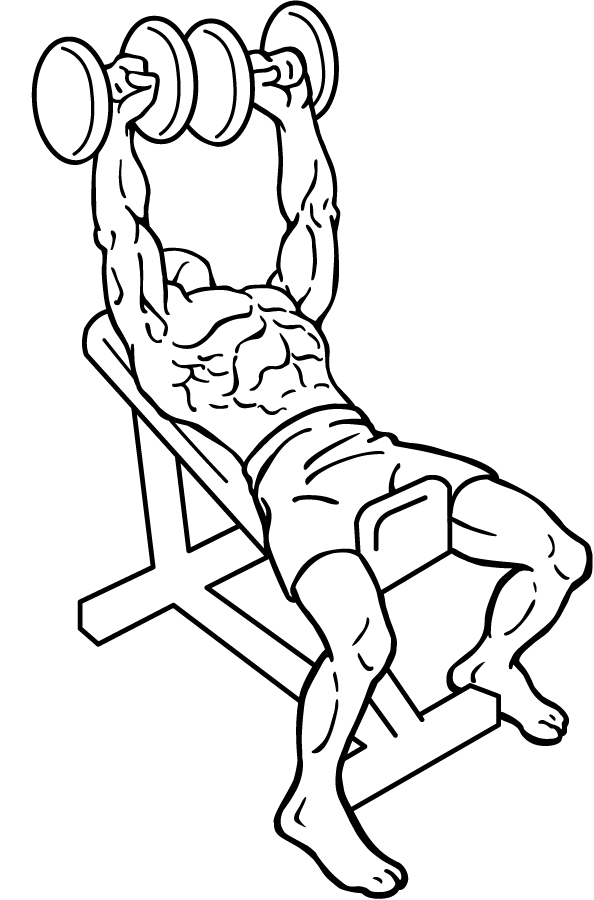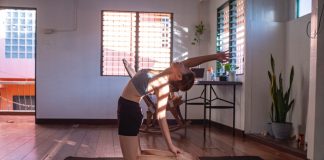Last Updated on September 30, 2022
The Incline Dumbbell Press is a staple in upper-body workouts, designed primarily to build and strengthen the chest while also targeting the triceps and shoulders. Whether you’re aiming for muscle growth, improved strength, or enhanced definition, the incline dumbbell press is a versatile and effective movement that deserves a spot in your routine. This comprehensive guide will take you through everything you need to know about this exercise, from the benefits and proper technique to common mistakes, variations, and advanced tips.
What is the Incline Dumbbell Press?
The Incline Dumbbell Press is a compound movement that engages multiple muscle groups simultaneously. The exercise involves lying on an incline bench and pressing dumbbells upwards, primarily targeting the upper portion of the chest (pectoralis major) while also recruiting the triceps and front deltoids (shoulders). It’s a great alternative to the flat bench press, offering an emphasis on the upper chest for more balanced chest development.
Muscles Worked:
- Pectoralis Major (Clavicular Head): The upper portion of the chest muscles, which are the primary target.
- Triceps Brachii: The muscles located at the back of the upper arm that assist in the pressing motion.
- Anterior Deltoids: The front part of the shoulder muscles, which support and stabilize the movement.
Benefits of the Incline Dumbbell Press
- Targets the Upper Chest:
- The incline position shifts the emphasis to the upper chest, an area often overlooked in traditional flat bench workouts. This helps create a more balanced and fuller chest appearance.
- Engages Multiple Muscle Groups:
- This compound exercise not only strengthens the chest but also recruits the shoulders and triceps, making it a time-efficient movement for building upper-body strength and mass.
- Increases Shoulder Stability:
- By incorporating the anterior deltoids, the incline press enhances shoulder stability and strength, which is crucial for overall upper-body development and injury prevention.
- Range of Motion and Muscle Activation:
- The use of dumbbells allows for a greater range of motion compared to a barbell, ensuring deeper muscle activation and promoting balanced muscle growth on both sides of the chest.
- Versatility:
- The incline dumbbell press can be modified to suit different fitness levels, making it accessible for beginners while providing advanced lifters with the flexibility to increase intensity.
How to Perform the Incline Dumbbell Press Properly
Step-by-Step Guide:
- Set Up the Bench:
- Adjust the bench to an incline angle between 30 and 45 degrees. An angle below 30 degrees may not adequately target the upper chest, while an angle above 45 degrees may shift the focus more to the shoulders.
- Get Into Position:
- Sit on the bench and plant your feet firmly on the ground for stability. Hold a dumbbell in each hand, resting them on your thighs.
- Lift the Dumbbells:
- Using your thighs for momentum, lift the dumbbells up to shoulder height. Your arms should be wide, elbows pointing downward, and palms facing forward. This is your starting position.
- Press the Dumbbells Up:
- Push the dumbbells upward until your arms are fully extended above your chest, but keep a slight bend in your elbows to avoid locking them. As you press, bring the dumbbells closer together without touching them.
- Control the Descent:
- Slowly lower the dumbbells back down to shoulder height, ensuring your elbows point down and stay in line with your shoulders. Maintain control throughout the descent to engage the chest muscles fully.
- Repeat for Reps:
- Aim for 3–4 sets of 8–12 reps, focusing on controlled motion and muscle engagement to maximize results.
Variations of the Incline Dumbbell Press
To keep your chest workout dynamic and target muscles from different angles, you can incorporate various incline dumbbell press variations:
- Single-Arm Incline Dumbbell Press:
- Perform the press with one arm at a time. This unilateral variation challenges your core stability and helps correct any muscle imbalances.
- Incline Dumbbell Press with Twist:
- As you press the dumbbells up, twist your palms so they face each other at the top. This variation engages the upper chest and triceps differently and adds a unique contraction at the peak of the movement.
- Incline Press with Resistance Bands:
- For added intensity, attach resistance bands to the bench and loop them around your dumbbells. This provides extra tension during both the lifting and lowering phases, enhancing muscle activation.
- Incline Neutral-Grip Dumbbell Press:
- Hold the dumbbells with your palms facing each other throughout the movement. This variation reduces shoulder strain and increases triceps engagement, making it ideal for those with shoulder issues.
- Incline Fly Press Combo:
- Alternate between performing a traditional incline press and an incline dumbbell fly within the same set. This hybrid approach maximizes chest activation and stretches the pectoral muscles, enhancing muscle growth.
Common Mistakes to Avoid
Even though the incline dumbbell press is a straightforward exercise, it’s easy to make mistakes that can reduce effectiveness or lead to injury:
- Setting the Bench Angle Too High:
- Setting the bench above 45 degrees shifts the focus to the shoulders rather than the chest. Stick to an angle between 30 and 45 degrees for optimal chest engagement.
- Arching the Lower Back:
- Maintain contact with the bench and avoid arching your lower back, as this reduces chest activation and places strain on the spine. Engage your core to keep your torso stable.
- Locking the Elbows:
- Locking your elbows at the top of the movement can put unnecessary stress on the joints. Always keep a slight bend to protect the elbows and maintain muscle tension.
- Dropping the Dumbbells:
- Letting the dumbbells drop too quickly can lead to injury and reduces muscle activation. Focus on a controlled and slow descent for maximum engagement.
- Using Too Much Weight:
- Lifting weights that are too heavy compromises form and increases the risk of injury, particularly in the shoulders. Start with a manageable weight and increase it gradually as your strength improves.
Tips for Maximizing Your Incline Dumbbell Press
- Warm Up Thoroughly:
- Before starting your sets, warm up your chest, shoulders, and triceps with dynamic stretches or light exercises like push-ups or resistance band chest presses.
- Use a Spotter for Heavy Sets:
- If lifting heavy weights, having a spotter can provide support and ensure you maintain proper form throughout your set.
- Engage Your Core:
- Keep your core tight during the press to stabilize your body and prevent your lower back from arching. This ensures better posture and protects your spine.
- Focus on the Mind-Muscle Connection:
- Visualize your chest muscles contracting as you press the dumbbells upward. Concentrating on the movement enhances muscle activation and promotes growth.
- Implement Progressive Overload:
- Increase the weight, reps, or sets gradually over time to challenge your muscles and encourage growth. Tracking your progress and pushing yourself regularly is key to long-term development.
Incline Dumbbell Press vs. Other Chest Exercises
To achieve a balanced chest development, it’s important to understand how the incline dumbbell press compares with other exercises:
- Flat Bench Press: Targets the middle chest, making it a fundamental chest-building exercise. Incorporating both flat and incline presses ensures complete chest development.
- Decline Bench Press: Emphasizes the lower chest. Combining decline, flat, and incline presses in your routine provides well-rounded chest growth.
- Incline Barbell Press: Similar to the dumbbell variation but uses a barbell, which can allow for heavier lifts but limits the range of motion. Dumbbells offer more flexibility and help correct muscle imbalances.
The Science Behind the Incline Dumbbell Press
The incline angle places greater tension on the upper portion of the pectoral muscles, encouraging growth in areas often neglected by the flat bench press alone. Research shows that incorporating multiple angles in your chest workouts helps achieve more balanced muscle development and reduces the risk of overuse injuries.
Additionally, using dumbbells allows for greater stabilization and muscle activation compared to barbells. Dumbbells force each side of the body to work independently, ensuring balanced muscle growth and preventing dominant side imbalances.
Advanced Tips for the Incline Dumbbell Press
- Try Eccentric Reps:
- Slow down the lowering phase of the movement (eccentric phase) to increase time under tension, promoting muscle growth and strength development.
- Implement Drop Sets:
- After reaching failure with a heavy weight, immediately reduce the weight and continue pressing until failure again. Drop sets are a powerful way to push your muscles beyond their limits.
- Superset with Push-Ups:
- Combine incline dumbbell presses with incline push-ups to further exhaust the chest muscles and maximize hypertrophy.
Nutrition and Recovery: Supporting Chest Growth
A solid incline dumbbell press routine should be complemented with proper nutrition and recovery strategies:
- Protein Intake: Aim for 1.6–2.2 grams per kilogram of body weight to support muscle repair and growth.
- Carbohydrates and Healthy Fats: Incorporate these for sustained energy and muscle recovery. Complex carbs like sweet potatoes, brown rice, and quinoa, along with healthy fats such as avocados, olive oil, and nuts, provide the necessary fuel for intense workouts.
- Hydration: Drinking plenty of water is crucial for muscle function and recovery. Aim for at least 8–10 glasses per day, and consider increasing your intake during and after workouts to replace fluids lost through sweat.
- Sleep and Recovery: Prioritize 7–9 hours of quality sleep per night to give your muscles the time they need to repair and grow. Rest days are equally important; ensure you have at least 1-2 rest days per week to avoid overtraining and allow muscle recovery.
Sample Incline Dumbbell Press Workout Routine
Integrating the incline dumbbell press into a well-rounded workout can maximize your upper body gains. Here’s a sample routine designed to build strength and sculpt the upper chest:
- Warm-Up:
- Dynamic stretches and mobility exercises (5–10 minutes).
- Light incline push-ups (2 sets of 12 reps).
- Incline Dumbbell Press:
- 4 sets of 8–12 reps (start with a moderate weight and increase progressively).
- Incline Chest Flyes:
- 3 sets of 10–12 reps (focus on controlled motion for a full stretch).
- Flat Bench Press:
- 3 sets of 8–10 reps (alternate with the incline press to target different chest areas).
- Cable Crossovers:
- 3 sets of 12–15 reps (emphasize the squeeze at the end of each rep for maximum chest engagement).
- Tricep Dips:
- 3 sets to failure (engages the triceps, complementing the chest work done).
- Cool Down:
- Static stretches for the chest, shoulders, and triceps (5–10 minutes).
Incline Dumbbell Press for Beginners and Advanced Lifters
The incline dumbbell press is versatile enough to cater to different fitness levels:
Beginners:
- Start with lighter weights to get comfortable with the movement. Focus on form and control rather than lifting heavy. Using a spotter or trainer to guide you is a good idea if you’re new to weight training.
Advanced Lifters:
- Advanced lifters can challenge themselves with heavier weights and more complex techniques like drop sets or supersets. For an extra challenge, consider incorporating incline presses with bands or stability exercises to engage the core and stabilizer muscles further.
The Importance of Proper Form
Maintaining proper form is key to maximizing muscle activation and avoiding injury. Remember to:
- Keep your back flat against the bench and your feet planted on the floor.
- Maintain a slight bend in your elbows throughout the movement.
- Avoid arching your lower back; engage your core to stabilize your body.
- Use a weight that allows you to perform each rep with control, prioritizing form over the amount of weight lifted.
Common Questions About the Incline Dumbbell Press
1. What is the ideal incline angle?
- The best angle for the incline dumbbell press is between 30 and 45 degrees. An angle below 30 degrees may not sufficiently target the upper chest, while an angle above 45 degrees may engage the shoulders more than the chest.
2. How does the incline dumbbell press differ from the barbell variation?
- The dumbbell variation allows for a greater range of motion and engages stabilizer muscles, promoting balanced muscle development. The barbell press, on the other hand, is ideal for lifting heavier weights but may limit movement range and isolate the muscles less effectively.
3. Can incline dumbbell presses replace flat bench presses?
- While incline presses are excellent for developing the upper chest, they should not entirely replace flat bench presses. A well-rounded chest routine should include both flat and incline movements to ensure comprehensive muscle development.
4. Should I perform the incline dumbbell press at the beginning or end of my workout?
- It’s generally best to perform compound exercises like the incline dumbbell press early in your workout when your muscles are fresh. This allows you to lift heavier weights with proper form, maximizing strength and hypertrophy.
Final Thoughts
The Incline Dumbbell Press is an essential exercise for anyone looking to build a strong, sculpted upper chest. By emphasizing the upper portion of the pectoral muscles while also engaging the triceps and shoulders, this movement offers balanced upper-body development. Whether you’re a beginner working on form or an advanced lifter seeking a challenging variation, the incline dumbbell press provides versatility and effectiveness.
To get the most out of this exercise, focus on proper technique, avoid common mistakes, and incorporate progressive overload. Combined with a well-rounded workout plan, proper nutrition, and adequate recovery, the incline dumbbell press can help you achieve your upper-body strength and aesthetic goals.
So next time you hit the gym, don’t skip the incline dumbbell press. Make it a key part of your routine, and watch your chest, triceps, and shoulders grow stronger and more defined.








